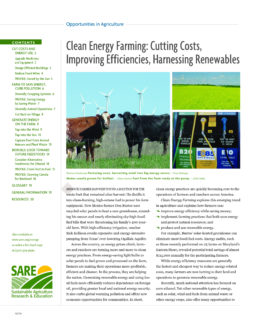In addition to switchgrass, researchers are currently exploring more than 81 fuel sources for ethanol, including:
Hulless Barley: Barley can do double duty as a cover crop and energy crop.
Hybrid Poplars: These poplars can be planted on marginal land, and converted into ethanol or used directly for heat. Poplars have excellent energy crop potential because they require few pesticides and fertilizers and grow well on land unsuitable for food crops, such as old mining or wastewater treatment sites.
Algae: Already known to be highly efficient at capturing nutrients, algae are currently in use at the USDA-Agricultural Research Service (ARS) site in Maryland to filter dairy wastewater. Researchers believe it could generate methane, or be converted directly into biodiesel or ethanol.
Alfalfa: New varieties don’t lodge and require less frequent harvesting than a typical forage crop. Researchers at the USDA-ARS in St. Paul, Minn., have shown initial yield increases of 42 percent. Decreased cuttings protect nesting birds in the spring. Alfalfa also has low energy input requirements, fixing its own nitrogen. One more added benefit: Growers already know how to produce alfalfa and it slots well into existing rotations.
Mixtures of Native Species: Work by ecologist David Tilman of the University of Minnesota suggests that growing mixtures of native species may produce more biomass and fewer fluctuations in productivity than one or a few species of grasses. Like switchgrass, mixed species produce far more net energy than corn and soybeans and require minimal fertilizer and pesticide inputs. Native species can also be grown on marginal lands and are more resilient to drought and pests. As an added benefit, they store more carbon than they release.
